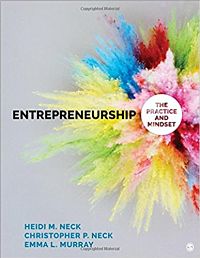Heidi Neck on Entrepreneurship in Teaching Future Entrepreneurs

How do you teach someone to be entrepreneurial? That’s the challenge presented to Heidi Neck, the Jeffry A. Timmons Professor of Entrepreneurial Studies at Babson College and director of the Babson Entrepreneur Experience Lab, every day. Her approach to teaching something that’s inherently “chaotic and nonlinear” is to embody the attributes of being entrepreneurial – whether in her own life, in the classroom, at company’s meeting rooms, and even in her writing – so that apart from merely telling learners what to do, she’s showing them.
This approach has won Neck plaudits for her teaching and course design from organizations such as the Academy of Management and the United States Association for Small Business & Entrepreneurship. She, along with co-authors Christopher P. Neck, and Emma L. Murray, put some of this wisdom into a textbook, Entrepreneurship: The Practice and Mindset. The new book, published by Social Science Space parent SAGE, just received the Most Promising New Textbook Award from the Textbook & Academic Authors Association. It’s not just the pros who appreciate the book; so do professors who appreciate the book’s real-world complexion. “Students learn so much by hearing strategies of overcoming ‘what went wrong’ and how to do it right the next time,” wrote Ann Gresock at the University of Michigan, Flint. “I COMMEND THE AUTHORS for taking this approach and am glad that they included this vital part of the entrepreneurial process.”
Given Neck’s successes, we talked with Neck about entrepreneurship as a subject of study, and then how to study entrepreneurship.
How do you define entrepreneurship? How widely accepted is your definition of entrepreneurship?
Heidi Neck: I try not to define entrepreneurship because it just gets me in trouble. I even tell my students, “Don’t define entrepreneurship, just do it.” In the textbook, we talk about it as a practice of discovering, creating, and acting on opportunities. In reality there are hundreds of definitions. Some of the definitions are limiting in that entrepreneurship is simply the act of starting a business, but I prefer the broader definitions that define entrepreneurship as a way of thinking and acting to identify opportunities of all kinds under conditions of uncertainty. Regardless of definition, the commonality across many of them is the act of creating something new or better.
Within entrepreneurship education I believe more and more educators are accepting broader definitions of entrepreneurship. Not all students that enter an entrepreneurship course or program of study will start a new business or even want to, but the skills learned and mindset developed in such courses is transferrable to any path a student may take. The goal of our textbook is to help build a more entrepreneurial generation.
Could you give some examples of your own entrepreneurial activities (like FlowDog!)?
HN: Where do you want me to start? At age 8, I started a frozen lemonade/Kool-Aid stand in front of my house where I quickly learned I needed to move it to a busy intersection in the neighborhood. Then later with “my gang” of friends we put on a neighborhood fair where kids and their parents would pay to play all the games we had set up. Prizes were kind of stolen from our homes (think recycled stuffed animals!) In college, I got involved in a lot of pyramid selling schemes – sold MCI long distance, which no longer exists! I had my own sales business selling a special type of wrench in Sears (don’t ask – it was a bad time for me). I developed my own leadership training program right after college that didn’t go too far. Sold the training to a few nonprofit organizations but I quickly learned about scale issues! Started consulting to small businesses during my MBA program mostly writing business plans for startups. I think that’s when I started to feel that business plans were overrated!
In 2009 I co-founded a company called FlowDog (featured in the text) that provides physical therapy to dogs (and some cats!). The company was sold to large animal hospital in 2017. And, finally, I co-founded VentureBlocks, a education simulation company (also featured in the book). Oh, and as one can imagine, I work with lots of student startups and sit on some of their advisory boards.
It seems that there could easily be a tension between entrepreneurship, which is an action-based discipline, and a textbook, which is static. How did you address this tension when writing the text?
HN: The tension is certainly there and I have experienced this tension myself. For years I refused to use a textbook because I wanted my courses to be 100 percent action-based, current, and engaging. The problem, however, is that I still had to find readings to supplement and elevate what I was doing in the classroom. My greatest personal tension with a textbook is that I never wanted “to teach to the text.” If the students read the text and then I lectured on the text, then why did they need the text in the first place? Or why did they need my lecture? Additionally, if I forced students to buy a textbook then I felt forced to teach to it. In writing the text, we had to figure out a way to balance three things: 1) content (what is being taught), 2) pedagogy (how is it being taught), and 3) relevance (do the frameworks and examples represent the most current thinking?).
I don’t like to lecture. My rule of thumb is never to talk more than 10 minutes before having the students do something active. I wanted to share those activities with the instructors that adopted the book. For each chapter there is an experiential exercise that only instructors have access to (not students) that engage the students with the content. It also makes it look like the instructors spent a lot of time creating an exercise for the students rather than “teaching to the text.” I wanted instructors to look and feel like rock stars in the classroom!
What is your favorite thing about teaching entrepreneurship?
HN: If you believe, like I do, that entrepreneurship can change the world, then being an entrepreneurship educator is both an enormous responsibility and gift. We must continuously challenge ourselves to become better educators and push pedagogical boundaries to do things better and differently. With such a responsibility and gift, I have the obligation and freedom to experiment in my teaching to help my students better practice entrepreneurship. Teaching entrepreneurship never gets old!
Top Five Things Entrepreneur Educators Worry About
And the larger question: how exactly do you teach entrepreneurship? What are some metrics that show you’re succeeding in teaching (or in learning)?
HN: Well, you have to be very entrepreneurial! I often tell faculty that if we cannot be entrepreneurial educators, then how can we expect to develop the entrepreneurial spirit of our students? My goal in teaching entrepreneurship is to make sure that students leaving my course are thinking and acting more entrepreneurially than when they entered. I teach in a way that allows students to practice entrepreneurship, which means they try, fail, experiment, create, play, talk with strangers, prototype, sell, iterate, build confidence, overcome fears, laugh, and even cry. They analyze markets, talk to customers, identify needs, develop business models, test new ideas, and pitch opportunities.
In that vein, I’m intrigued by the ‘Mindshift Activity’ within each chapter. How do you get someone to not only learn but to embody and practice entrepreneurship?
HN: Developing an entrepreneurial mindset takes practice, which means you have to take lots of actions in order to develop habits around creating, experimenting, empathizing, and reflecting on actions. The Mindshifts help students build a habit of thinking and acting entrepreneurially. Again, it’s not enough to read about entrepreneurship; you have to do entrepreneurship.
Could you describe the collaborative process between you, Chris and Emma in writing this book?
HN: Writing a textbook is unlike any other writing activity. It requires a very disciplined system with accountability to each other and the deadlines. Chris, Emma, and I each had our roles and these were determined at the start of the writing process. This was my first textbook but Chris and Emma worked on other texts, so their experience in creating the system was instrumental. Because of their system we never missed a deadline and published on time!
























































































